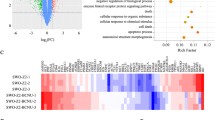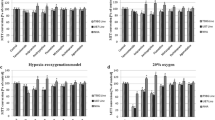Abstract
Several antidepressants, mainly selective serotonin-reuptake inhibitors (SSRIs) and some tricyclic antidepressants (TCAs), have been shown to possess potent apoptotic activity in different cell lines. Our aim was to screen and select those agents with significant activity and elucidate the molecular pathway underlying this process in rat glioma and human neuroblastoma cell lines. We studied the effect of different antidepressants on apoptotic markers, including: cell viability, DNA fragmentation, cytochrome c (Cyt c) release from mitochondria, and caspase-3-like activity. In addition, the involvement of MAPK genes, c-Jun, and ERK was determined. Paroxetine and fluoxetine, SSRIs, clomipramine, a TCA, but not imipramine or mianserin (an atypical antidepressant), caused apoptosis in both cell lines, as assessed by flow cytometry of propidium iodide-stained C6 cells and typical fluorescence microscopy in glioma cells. These apoptotic changes were preceded by rapid increase in p-c-Jun levels, Cyt c release from mitochondria, and increased caspase-3-like activity. Assessment of paroxetine cytotoxicity in primary mouse brain and neuronal cultures showed significantly lower sensitivity to the drug’s proapoptotic activity. These results strongly suggest that selected antidepressants induce apoptosis in neuronal and glial cell lines. Activation of p-c-Jun and subsequent increased Cyt c mitochondrial release participate in the apoptotic mechanism of the antidepressant. The high sensitivity to these drugs of the cancer cell, compared with primary brain tissue, suggests the potential use of these agents in the treatment of brain-derived tumors.
Similar content being viewed by others
References
Abdul M., Logothetis C. J., and Hoosein N. M. (1995) Growth inhibitory effects of serotonin uptake inhibitors on human prostate carcinoma cell-lines. J. Urol. 154, 247–250.
Altamura A. C., Moro A. R., and Percudani M. (1994) Clinical pharmacokinetics of fluoxetine. Clin. Pharma-cokinet. 26, 201–214.
Azmitia E. C. (2001) Modern views on an ancient chemical: serotonin effects on cell proliferation, maturation, and apoptosis. Brain Res. Bull. 56, 413–424.
Barbey J. T. and Roose S. P. (1998) SSRI safety in overdose. J. Clin. Psychiatry 59(Suppl. 15), 42–48.
Behrens A., Sibilia M., and Wagner E. F. (1999) Aminoterminal phosphorylation of c-Jun regulates stress-induced apoptosis and cellular proliferation. Nat. Genet. 21, 326–329.
Bernardi P., Petronilli V., Di Lisa F., and Forte M. A. (2001) A mitochondrial perspective on cell death. Trends Biochem. Sci. 26, 112–117.
Beutner G., Ruck A., Riede B., and Brdizka D. (1998) Complexes between porin, hexokinase, mitochondrial creatine kinase and adenylate cyclase display properties of the permeability transition pore. Implication for regulation of permeability transition by the kinases. Biochim. Biophys. Acta 1368, 7–18.
Bolo N. R., Hode Y., Nedelec J. F., Laine E., Wagner G., and Macher J. P. (2000) Brain pharmacokinetics and tissue distribution in vivo of fluvoxamine and fluoxetine by fluorine magnetic resonance spectroscopy. Neuropsychopharmacology 23, 428–438.
Bossy-Wetzel E., Newmeyer D. D., and Green D. R. (1998) Mitochondrial release in apoptosis occurs upstream of DEVD-specific caspase activation and independently of mitochondrial transmembrane depolarization. EMBO J. 17, 37–49.
Borenfreund E. and Puerner J. A. (1984) A simple procedure using monolayer cultures for cytotoxicity assays (HTR/NR-90). J. Tissue Culture Methods 9, 7–9.
Brustugun O. T., Fladmark K. E., Doskeland S. O., Orrenius S., and Zhivotovsky B. (1998) Apoptosis induced by microinjection of cytochrome c is caspase-dependent and is inhibited by Bcl-2. Cell Death Differ. 5, 660–668.
Castren E. (2004) Neurotrophic effects of antidepressant drugs. Curr. Opin. Pharmacol. 4, 58–64.
Derijard B., Raingeaud J., Barrett T., Wu I. H., Han J., Ulevitch R. J., and Davis R. J. (1995) Independent human MAP-kinase signal transduction pathways defined by MEK and MKK isoforms. Science 267, 682–687.
Dickens M., Rogers J. S., Cavanagh J., Raitano A., Xia Z., Halpern J., et al. (1997) A cytoplasmic inhibitor of the JNK signal transduction pathway. Science 277, 693–696.
Estus S., Zaks W. J., Freeman R. S., Gruda M., Bravo R., and Johnson E. M. Jr. (1994) Altered gene expression in neurons during programmed cell death: identification of c-jun as necessary for neuronal apoptosis. J. Cell Biol. 127, 1717–1727.
Gil-Ad I., Offen D., Shtaif B., Gallili-Mosberg R., and Weizman A. (1998) Haloperidol induces neurotoxicity in mouse embryo brain tissue. Evidence for oxidative damage mechanism, and implication for tardive dyskinesia, in Progress in Alzheimer’s and Parkinson’s Diseases, Fisher, A., Yoshida, M., and Hanin, I., (eds.), Plenum Press, New York, pp. 163–169.
Gil-Ad I., Shtaif B., Levkovitz Y., Dayag M., Zeldich E., and Weizman A. (2004) Characterization of phenothiazine-induced apoptosis in neuroblastoma and glioma cell-lines. J. Mol. Neurosci. 22, 189–198.
Goodwin G. M. (1992) Tricyclic and newer antidepressants, in Handbook of Affective Disorders, Paykel, E. S., (ed.), Churchill Livingstone, Edinburgh, pp. 327–345.
Gram L. F. (1994) Fluoxetine. N. Engl. J. Med. 17, 1354–1361.
Ham J., Babij C., Whitfield J., Pfarr C. M., Lallemand D., Yaniv M., and Rubin L. L. (1995) A c-Jun dominant negative mutant protects sympathetic neurons against programmed cell death. Neuron 14, 927–939.
Harel A., Bloch O., Vardi P., and Bloch K. (2002) Sensitivity of HaCat keratinocytes to diabetogenic toxins. Biochem. Pharmacol. 63, 171–178.
Holsboer F. and Barden N. (1996) Antidepressants and hypothalamic-pituitary-adrenocortical regulation. Endocr. Rev. 177, 187–205.
Karson C. N., Newton J. E., Livingston R., Jolly J. B., Cooper T. B., Sprigg J., and Komoroski R. A. (1993) Human brain fluoxetine concentrations. J. Neuropsychiatry Clin. Neurosci. 5, 322–329.
Kyriakis J. M., Banerjee P., Nikolakaki E., Dai T., Rubie E. A., Ahmad M. F., et al. (1994) The stress-activated protein kinase subfamily of c-Jun kinases. Nature 369, 156–160.
Levkovitz Y. and Baraban J. M. (2001) A dominant negative inhibitor of the Egr family of transcription regulatory factors suppresses cerebellar granule cell apoptosis by blocking c-Jun activation. J. Neurosci. 21, 5893–5901.
Mercier G., Lennon A. M., Renouf B., Dessouroux A., Ramauge M., Courtin F., and Pierre M. (2004) MAP kinase activation by fluoxetine and its relation to gene expression in cultured rat astrocytes. J. Mol. Neurosci. 24(2), 207–216.
Nicolletti I., Migliorato G., Pagliacci M. C., Grimsani F., and Riccardi C. (1991) A rapid and simple method for measuring thymocyte apoptosis by propidium iodide staining and flow cytometry. J. Immunol. Methods 139, 271–279.
Peer D., Dekel Y, Melikhov D., and Margalit R. (2004) Fluoxetine inhibits multidrug resistance extrusion pumps and enhances responses to chemotherapy in syngenic and in human xenograft tumor models. Cancer Res. 64, 7562–7569.
Post A., Crochemore C., Uhr M., Holsberg F., and Behl C. (2000) Differential induction of NF-κB activity and neural cell death by antidepressants in vitro. Eur. J. Neurosci. 12, 4331–4337.
Preskorn S. H. (1996) Clinical Pharmacology of Selective Serotonin Reuptake Inhibitors, Professional Communications, Caddo, OK.
Russo-Neustadt A. A., Alejandre H., Garcia C., Ivy A. S., and Chen M. J. (2004) Hippocampal brain-derived neuro-trophic factor expression following treatment with reboxetine, citalopram, and physical exercise. Neuro-psychopharmacology 29, 2189–2199.
Seckel J. R. and Fink G. (1992) Antidepressants increase glucocorticoid and mineralocorticoid receptor mRNA expression in rat hippocampus in vivo. Neuroendocrinology 55, 621–626.
Serafeim A., Holder M. J., Grafton G., Chamba A., Drayson M. T., Luong Q. T., et al. (2003) Selective serotonin reuptake inhibitors directly signal for apoptosis in biopsy-like Burkittlymphoma cells. Blood 101, 3212–3219.
Spanova A., Kovaru H., Lisa V., Lukasova E., and Rittich B. (1997) Estimation of apoptosis in C6 glioma cells treated with antidepressants. Physiol. Res. 46, 161–164.
Talanian R. V., Quinlan C., Tranz S., Hackett M. C., Mankovieh J. A., Banach D., et al. (1997) Substrate specificities of caspase family proteases. J. Biol. Chem. 272, 9677–9682.
Watson A., Eilers A., Lallemand D., Kyriakis J., Rubin L. L., and Ham J. (1998) Phosphorylation of c-Jun is necessary for apoptosis induced by survival signal withdrawal in cerebellar granule neurons. J. Neurosci. 18, 751–762.
Weitsman G., Ravid A., Liberman U., and Koren R. (2003) vitamin D enhances caspase-dependent and caspase-independent TNFα-induced breast cancer cell death: the role of reactive oxygen species and mitochondria. Int. J. Cancer 106, 178–186.
Xia Z., DePierre J. W., and Nassberger L. (1998) Modulation of apoptosis induced by tricyclic antidepressants in human peripheral lymphocytes. J. Biochem. Mol. Toxicol. 12, 115–123.
Xia Z., DePierre J. W., and Nassberger L. (1996) The tricyclic antidepressants clomipramine and citalopram induce apoptosis in cultured human lymphocytes. J. Pharm. Pharmacol. 48, 115–116.
Xia Z., Dickens M., Raingeaud J., Davis R. J., and Greenberg M. E. (1995) Opposing effects of ERK and JNK-p38 MAP kinases on apoptosis. Science 270, 1326–1331.
Author information
Authors and Affiliations
Corresponding author
Rights and permissions
About this article
Cite this article
Levkovitz, Y., Gil-Ad, I., Zeldich, E. et al. Differential induction of apoptosis by antidepressants in glioma and neuroblastoma cell lines. J Mol Neurosci 27, 29–42 (2005). https://doi.org/10.1385/JMN:27:1:029
Received:
Accepted:
Issue Date:
DOI: https://doi.org/10.1385/JMN:27:1:029




